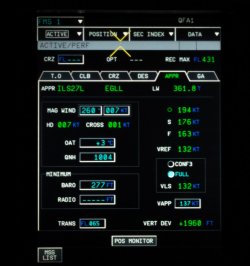Vapp is the Final approach speed when flaps full and landing gear deployed?. does it include a wind correction?
Flap could be full or 3 in normal ops. In two engines out, final flap was 3. I don't recall applying any wind correction in this case. FMC target speeds would automatically adjust, and we could override that with any adjustment that we wanted. I think we could bump it by up to 10 knots (I've forgotten and will ask), but it was very sensitive to change, and only 3-5 was normally needed in gusty conditions. 99% of the time we left it at whatever the FMC wanted.
VMCL2 ?? 2 engine minimum speed. The minimum speed at which the tendency to yaw in a 2 engine failure is controllable? because the slower the speed the less effective is the rudder?.
Vmca2 is the speed at which you cannot control the yaw, with go around power, full rudder, and 5º angle of bank. It was 144 knots in the 380, which is impressively slow given the moment arm and power that the engines had. The 747 was around 159 knots.
Most of the time on the two engine approach, the FMC generated approach speed would be greater than 144 knots, so it wasn't a consideration. But at light weights it could go below. It wasn't much, about 5 knots is all that I remember. When first converting on to the aircraft, we saw this and simply wondered why they wouldn't use 144 as the lower limit, and avoid any Vmca2 issues. The answer we were given was that if you increased the speed by much the aircraft pitch attitude would make a nose gear first landing too likely. I'm not sure of the validity of that answer, but the upshot is that at light weights, your final approach speed could well be below Vmca2. It did wonders for your accuracy.
In a 2 engine on one side out scenario:
- s the VMCL2 always? going to be lower than Vapp?
The FMC will generate the Vapp that it wants, irrespective of Vmca. But, the autothrust is limited by Vmca, and so if the Vapp is less than Vmca, it will not be able to reduce the speed to that figure. That's why we have to manually reset the target speed and fly the power. Vmca2 will be less than Vapp at heavier landing weights, but not at the low end. It's really a mix of behaviours between the FMC and the autothrust.
-can you please explain the directive to not attempt a GA when aircraft speed is below VMCL2?
At a speed less than Vmca2. Apply go around thrust and full rudder, aircraft starts to roll, and you'll need aileron to stop it. But, you may not be able to stop the yaw, and in the worst case, the roll. There is a limit of 15º of heading required by the regulatory authorities for the initial response to a go around (reducing to 5º).
Taking it to an extreme. If you were about 10 knots below Vmca2, and applied full power. Full rudder would not stop the yaw. Neither would full aileron. There would be a pregnant pause, and then the aircraft would probably flick. Lights out. It's a spin entry.















